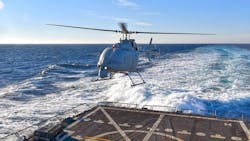Navy works with Northrop Grumman to add Link 16 tactical networking capability to MQ-8C unmanned helicopter
PATUXENT RIVER NAS, Md. – U.S. Navy unmanned helicopter experts plan to add tactical networking capability to enable the radar-equipped MQ-8C unmanned aerial vehicle (UAV) to share its radar picture with nearby ships, aircraft, and ground forces.
Officials of the Naval Air Systems Command at Patuxent River Naval Air Station, Md., announced plans Wednesday to continue developing a Link 16 tactical datalink capability for radar-equipped MQ-8C Fire Scout unmanned helicopters.
The Navy will negotiate a contract with MQ-8C manufacturer the Northrop Grumman Aeronautics Systems segment in San Diego to integrate and field a Link 16 tactical datalink capability into radar equipped MQ-8Cs.
This effort also will include procurement of as many as 38 retrofit kits and installs. The contract action requires expertise in MQ-8C aircraft engineering, integration and testing. The value of the upcoming contract has yet to be negotiated.
Link 16 is a military tactical data link network used by the U.S. military and its NATO allies that enables military aircraft, ships, and ground forces to exchange their tactical picture in near-real time. Link 16 also supports the exchange of text, imagery, and digital voice messages.
The MQ-8C unmanned helicopter is aboard Navy destroyers and other surface warships. These aircraft are based on the manned Bell 407 helicopter from Bell Helicopter Textron Inc. in Fort Worth, Texas.
The MQ-8C provides the Navy with an increased range of more than 30 percent, twice the endurance, and an increased payload capacity over the existing MQ-8B variant, which is based on the Schweizer 333 helicopter from Schweizer Aircraft Corp., now owned by Rotorcraft Services Group in Fort Worth, Texas. The unmanned systems architecture developed for the MQ-8B is re-used in the MQ-8C.
The primary advantage of the MQ-8C Fire Scout over its MQ-8B and MQ-8A versions is the newest shipboard UAV has double the useful payload of its predecessors. The newest model also has a somewhat faster top speed and slightly more maximum range than previous models of the Fire Scout.
For more information contact Northrop Grumman Aeronautics Systems online at www.northropgrumman.com, or Naval Air Systems Command at www.navair.navy.mil.

John Keller | Editor-in-Chief
John Keller is the Editor-in-Chief, Military & Aerospace Electronics Magazine--provides extensive coverage and analysis of enabling electronics and optoelectronic technologies in military, space and commercial aviation applications. John has been a member of the Military & Aerospace Electronics staff since 1989 and chief editor since 1995.

